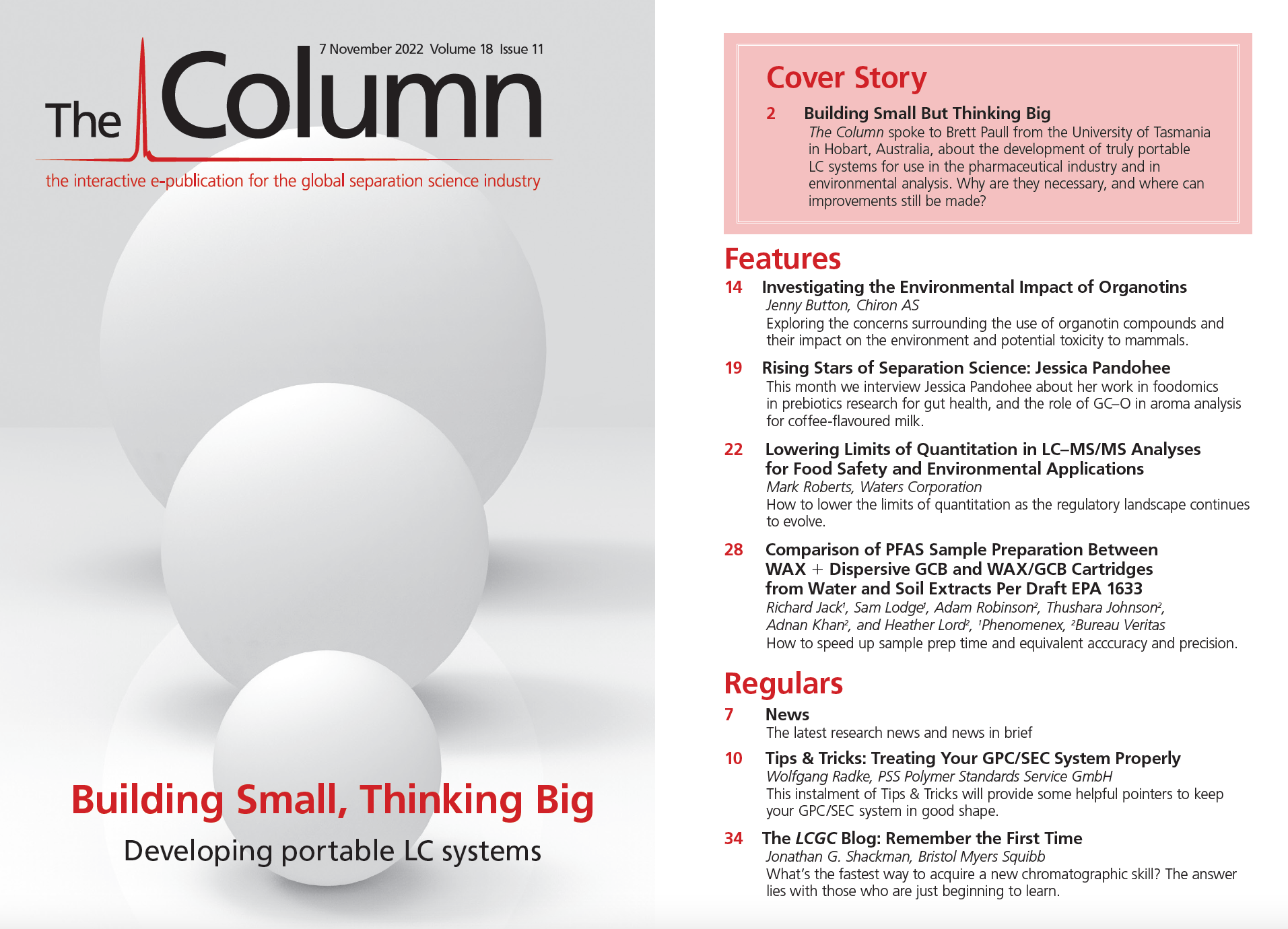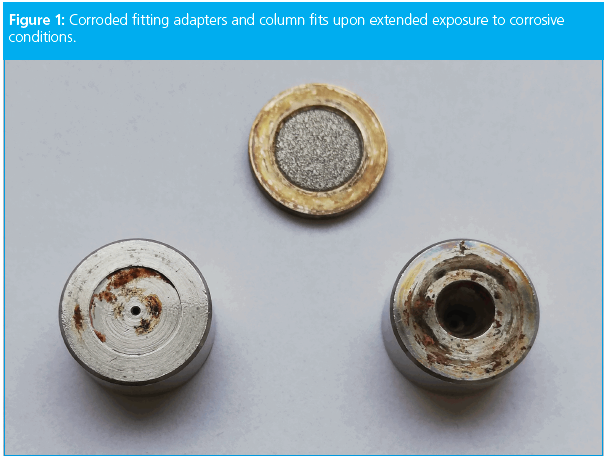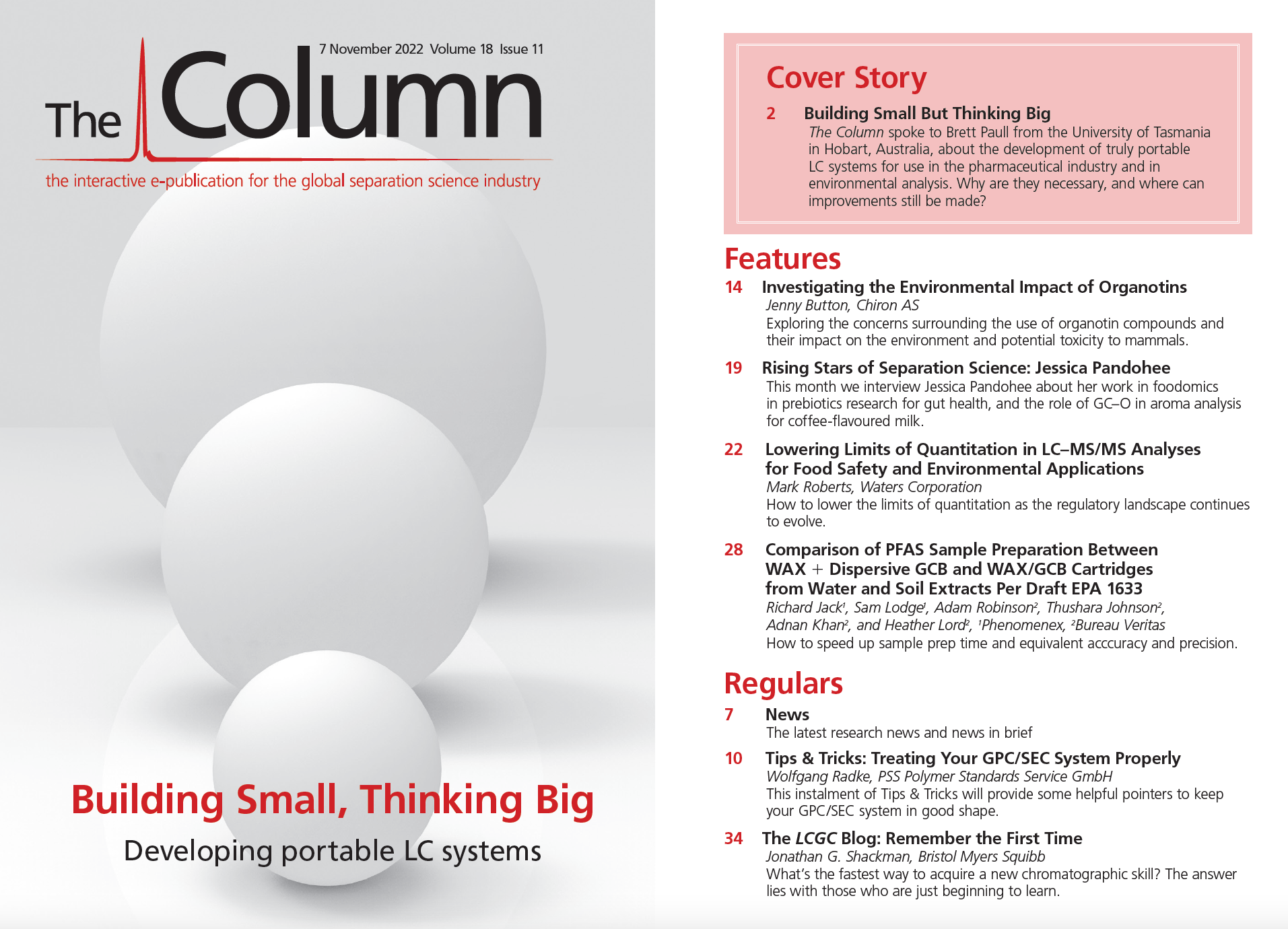Rising Stars of Separation Science: Jessica Pandohee
Q. When did you first encounter chromatography and what attracted you to the subject?
A: It was during my science class in my first year of high school that I was introduced to chromatography, more specifically paper chromatography. I was fascinated observing the separation of the colours that made up ink. This simple experiment motivated me to learn more about chemical science and understand the composition of things around us. Second year undergraduate analytical chemistry was undoubtedly one of my favourite courses, as I was exposed to the various types of chromatography and detection technologies and learnt how they work. The laboratory of Neil Barnett and Xavier Conlan at Deakin University was leading research in two‑dimensional liquid chromatography (2D‑LC) and chemiluminescence. The experience obtained from completing an undergraduate research project as part of my bachelor of forensic science and an honours project in their lab stimulated me to pursue research in the area of multidimensional chromatography.
Q. Can you tell us more about your Ph.D. thesis?
A: My Ph.D thesis involved the development and application of multidimensional chromatography techniques for targeted and nontargeted metabolomics analyses under the supervision of Oliver Jones. It was a joint project between RMIT University, Deakin University, and Victoria Police, and was supported by a top-up scholarship from the Commonwealth Scientific and Industrial Research Organization (CSIRO). Some of the tools I developed during that time include an on-column derivatization procedure using micro-solid-phase extraction (μ-SPE) columns, 2D-LC coupled with UV spectroscopy and chemiluminescence for metabolite profiling, and a novel chromophore for the analysis of fatty acids. These methods have primarily been optimized to answer biotechnological and industrial questions in a wide range of research fields. An example was the use of 2D-LC to investigate the effect of UV irradiation on the metabolome of mushrooms, or the use of comprehensive two-dimensional gas chromatography (GC×GC) to profile petrochemicals for arson cases. The research completed during my Ph.D received the RMIT Vice Chancellor Research Excellence Prize.
Q. What chromatographic techniques have you worked with?
A: Throughout my career I have worked with a vast variety of sample types, all requiring knowledge and expertise to decide the best approach to perform the experimental design, sample extraction, chromatographic and detection analyses, and the data analyses. Hyphenated chromatographic techniques, such as comprehensive two-dimensional liquid chromatography (LC×LC)–UV, LC×LC– UV‑chemiluminescence, GC×GC–flame ionization detection (FID), or GC×GC–quadrupole mass spectrometry (QMS), made up the bulk of the instruments I worked with during my Ph.D. As a visiting researcher at the University of Essen‑Duisburg, Germany, I worked on lipidomics of plant seeds using a LC×LC–UV–quadrupole time-of-flight (QTOF)‑ion mobility (IMS) system. Nowadays, MS-based metabolomics takes up the majority of my time. For untargeted experiments, I have worked with LC–MS (ion trap, orbital trap, ion-mobility, time of flight) and GC–MS (ion trap and orbital trap). For targeted analyses, I have worked with LC–MS (triple quad and orbital trap) and GC–MS (triple quad and orbital trap) with electron and chemical ionization. I have also been trained as a sensory analyst and worked on gas chromatography–olfactometry (GC–O) for the analyses of aromas and odours from food products. Other instruments that I have used for routine analyses and teaching include LC–UV, LC–refractive index detector (RID), LC–MS, GC–FID, GC–MS, inductively coupled plasma (ICP)-MS and matrix-assisted laser desorption– ionization (MALDI).
Q. Your research focus currently lies within food analysis—what specifically attracted you to this area of research?
A: Food played an important role in uniting our family for celebrations, birthdays, and festivals during my childhood. My grandparents often told me “we are what we eat”. Doing my Ph.D in bioanalytical food chemistry was a great way to combine my interest in food and passion for analytical methodologies. I have worked on food-related projects from many different perspectives. For example, studying diseases in crops using metabolomics, enhancing triglyceride content in seeds using lipidomics, investigating fatty acid profiles of oils, and exploring the effect of supplementation on health, amongst others. I am particularly interested in nutraceuticals and food that promote health benefits in humans. Food analysis has been a key skill in my research in bettering the quality and safety of food products, studying the effect of biotic and abiotic stress on cereals, and understanding how food can be used to improve our health and microbiome.
Q. You have recently published a paper discussing the role of foodomics in prebiotics research for gut health (1). How important is foodomics in this area?
A: Foodomics is a comprehensive approach to food analysis and nutrition. It may well in fact revolutionize research in understanding the role of food and its components on our health. Foodomics is a systems biology approach encompassing well-established techniques such as genomics, transcriptomics, proteomics, and metabolomics combined with bioinformatics. Prebiotics on the other hand are non-digestible components of food. In recent years, more compounds, such as polyphenols and fatty acids, have been shown to have prebiotic properties. A lot of research is still needed in this area to discover novel compounds with prebiotic effects and their mechanism of action. The use of foodomics is important is several fields of research. For example, it can be used to identify new prebiotic compounds in food, determine the role of prebiotics in humans, or understand the effect of consuming mixtures of prebiotics on our health. Moreover, foodomics could revolutionize the way we eat, paving the way for personalized nutrition and potentially treating health conditions and preventing illnesses through the consumption of certain food groups.
Q. From an analytical perspective what challenges do scientists involved in foodomics face?
A: One of the challenges that scientists working in foodomics face is a deluge of complex data. In a typical foodomics study, it is not uncommon for scientists to profile food and human biosamples at different omics levels. In order to obtain reliable results, it is important that advanced bioinformatics tools can merge the datasets without bias. Moreover, the lack of standardized methods in the area of foodomics makes it difficult to compare preclinical and clinical studies. Another difficulty is the characterization and identification of new bioactive compounds (unknown unknowns). Despite the rapid technological and computational advancements, there are a number of opportunities to improve the current standards in foodomics research.
Q. Do you see foodomics becoming more commonly used in practice?
A: The term “foodomics” was coined in 2009, when several of the omics were still in their infancy. In the last 15 years we have witnessed the development of chromatographic, mass spectrometric, and sequencing technologies allowing large-scale and high-throughput analyses. There has also been abundant open‑source scripts and packages released for different omics data analyses. The creation of international databases and their ongoing curation are facilitating the characterization of important biomolecules in foodomics studies. Therefore, I strongly believe that foodomics has the potential to be commonly used in various areas of research, routine industrial analyses, and personalized nutrition.
Q. Another of your recent papers presents a method for determining short-chain fatty acids in human serum using LC–MS (2). What does this method offer over existing ones?
A: Short-chain fatty acids are usually measured using GC–MS or GC–FID due to their volatile nature. In blood, the levels of short-chain fatty acids can be as low as the detection limit. Moreover, interference from the matrix or other chemical species render accurate quantification erroneous. In this paper, we compared the performance of three instruments—a GC–high resolution (HR)MS orbital trap, an LC–HRMS orbital trap, and a triple quadrupole (TQ)‑LC– MS using multiple reaction monitoring (MRM) mode—to determine the most suitable instrument for routine quantification of short‑chain fatty acids in serum. LC–MS provided an improvement in detection limit (1–7 ng/mL) and quantification limit (3–19 ng/mL) of derivatized short-chain fatty acids. The paper also discusses the resolution of acetic, butyric, and isovaleric acids from interferences using a C18 column.
Q. Aroma in food and drink is obviously important. You recently conducted a study into aroma evolution in coffee-flavoured milk using GC–O (3). How straightforward was it to apply GC–O in this analysis? What challenges did you face?
A: GC–O is a remarkable technique for the analysis of flavours and odours occurring in food. It provides scientists with an additional dimension to analyze biochemical information, through their sense of smell and taste. The instrumentation for GC–O is pretty straightforward. It involves coupling a gas chromatograph to a parallel olfactometry detection port and flame ionization detector. As a sensory analyst, my role was to sit at the end of the olfactometry detection port and record the descriptor and perceived intensity of each aroma or odour as I could smell them elute from the column. Although it was a very exciting project, one of the challenges we faced was low throughput, due to the fact that an analyst was always needed to smell and record the aromas. The analysis therefore required commitment for a long period of time for the correct sensory assessment. Working on this project was a great opportunity for me to train as a sensory analyst and appreciate the flavours and odours from food products as they change through time. I am looking forward to seeing more applications of GC–O in the field of volatile food metabolome.
References
- L.F.F. Lee Nen That, B. Xu, and J. Pandohee, Current Opinion in Food Science 48, 100920 (2022).
- A. Shafaei, V. Vamathevan, J. Pandohee, N.G. Lawler, D. Broadhurst, and M.C. Boyce, Analytical and Bioanalytical Chemistry 413, 6333–6342 (2021).
- J. Pandohee, M. Thornton, and R. Keast, International Journal of Dairy Technology 75, 329–337 (2022).
Jessica Pandohee

Jessica Pandohee holds a bachelor of forensic science (honours) from Deakin University, Australia, and a Ph.D. in applied chemistry from RMIT University, Australia. The motivation behind her research in analytical chemistry is to tackle global challenges arising from a growing food, water, and environmental insecurity, as well as public health and safety. Separation science, mass spectrometry, and bioinformatics are enabling tools in her research in the field of forensic science, food, agriculture, metabolomics, and microbiome. Jess has authored over 30 peer-reviewed publications. The success of her work has been recognized by the receipt of the Agilent Technologies Award for Separation Science (2015), and featuring the element “Lawrencium” in the 2019 Periodic Table of Young Chemists. Jess was also selected to attend the 67th Nobel Laureate Meeting in Lindau, Germany, which inspired her to further investigate complex problems, foster collaborations, and solve worldwide issues.
Rising Stars of Separation Science
The Column will be running a series of interviews in 2023, featuring the next generation of separation scientists. If you would like to nominate a “rising star” for consideration, please send the name of the candidate and why they deserve recognition to Alasdair Matheson, Editor‑in‑Chief, LCGC Europe and The Column at amatheson@mjhlifesciences.com

New Study Reviews Chromatography Methods for Flavonoid Analysis
April 21st 2025Flavonoids are widely used metabolites that carry out various functions in different industries, such as food and cosmetics. Detecting, separating, and quantifying them in fruit species can be a complicated process.
University of Rouen-Normandy Scientists Explore Eco-Friendly Sampling Approach for GC-HRMS
April 17th 2025Root exudates—substances secreted by living plant roots—are challenging to sample, as they are typically extracted using artificial devices and can vary widely in both quantity and composition across plant species.
Sorbonne Researchers Develop Miniaturized GC Detector for VOC Analysis
April 16th 2025A team of scientists from the Paris university developed and optimized MAVERIC, a miniaturized and autonomous gas chromatography (GC) system coupled to a nano-gravimetric detector (NGD) based on a NEMS (nano-electromechanical-system) resonator.

.png&w=3840&q=75)

.png&w=3840&q=75)



.png&w=3840&q=75)



.png&w=3840&q=75)


















